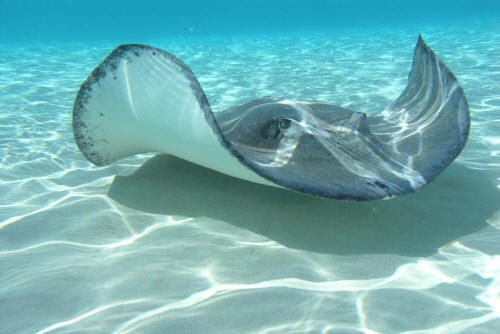
Manta rays can reach a wingspan of up to 23 feet and weigh up to 1.5 tons. Because of their peaceful nature and enormous size, these majestic creatures are often referred to as “gentle giants” of the sea. Manta rays are large cartilaginous fish in the Mobulidae family. These variations in their physical and ecological aspects lead to distinct feeding habits, reproductive strategies, and behavioural patterns between the two species. The majority of stingray species are commonly found near the coastline or in brackish waters.Manta rays are typically found in open oceans.Stingrays have a more compact, disk-like shape.Manta rays are distinguished by their large, flattened bodies and gracefully wide pectoral fins.

Physical differences can be seen in their body shapes and sizes. Understanding their differences can offer valuable insights into their ecological roles and conservation needs, further enriching knowledge of the marine ecosystem. Despite their many similarities, such as being cartilaginous fish and belonging to the same superorder, Batoidea, these two species have distinct characteristics and behaviours that set them apart. Scientific Reports, 6(February), 20970.Manta rays and stingrays are both fascinating sea creatures that have captured the attention of both marine enthusiasts and researchers. Critical assessment and ramifications of a purported marine trophic cascade.

Sharks of the World: a fully illustrated guide. How many trophic roles can elasmobranchs play in a marine tropical network? Marine and Freshwater Research, 1–12. A., López-García, J., Giraldo, A., & Cruz-Escalona, V. However, our taxonomic system (the system of naming species) still distinguishes elasmobranch fishes into cylindrically shaped sharks and flattened rays. Just like flounders are bony fish that are adapted to live on the bottom of the sea, rays are flattened elasmobranch fish adapted to live in seafloor habitats. So it is pretty correct to think of rays as flattened sharks. Sawsharks and sawfish do both use the rostrum for the same purpose: to stun prey 2,4. In addition, sawsharks have a pair of long barbels on the underside of the rostrum. The major difference to distinguish the two is that sawfishes (rays) have the gill openings on the underside of the body, whereas the sawsharks have the gill slits on both sides of the body like all other sharks. For example, the similar-looking sawfishes and sawsharks are ray and shark species respectively, but both get their name from their saw-like rostrum. There are, however, a couple of species who’s appearance might trick you in assessing whether is a shark or a ray. Rays are generally more specialized in their food sources compared to sharks, making their distribution limited to smaller areas, and the distribution of many, more mobile, shark species greater 2,3. Furthermore, the gill openings of rays are located on the underside of the body, whereas the gills of sharks are located on both sides of the body.

And in addition to the flattened body, the pectoral fins of rays are larger compared to those of sharks, and they are fused to the head, resulting in the unique body shape and swimming movements of rays. Obviously, the major difference between sharks and rays is their body shape.


 0 kommentar(er)
0 kommentar(er)
